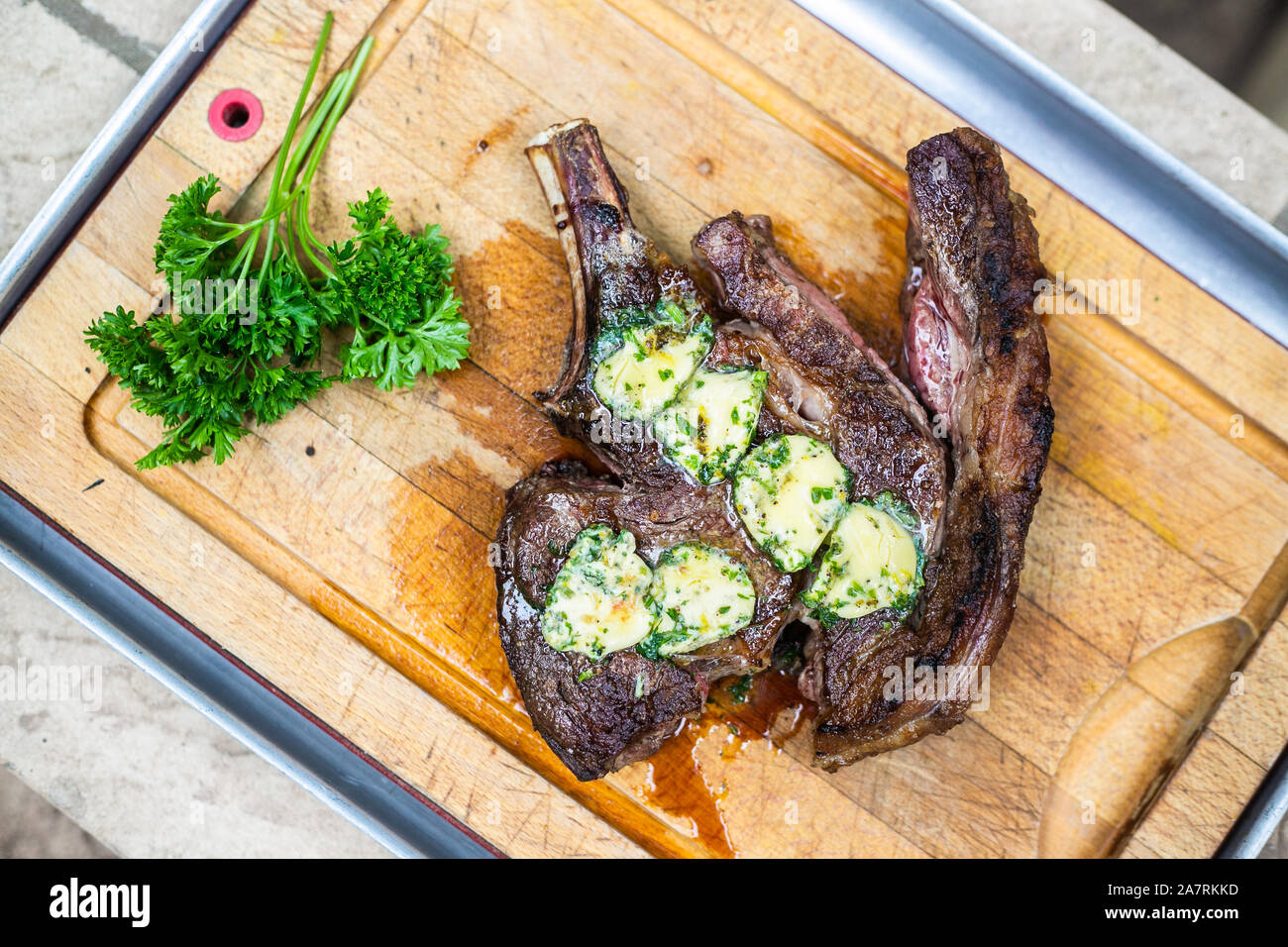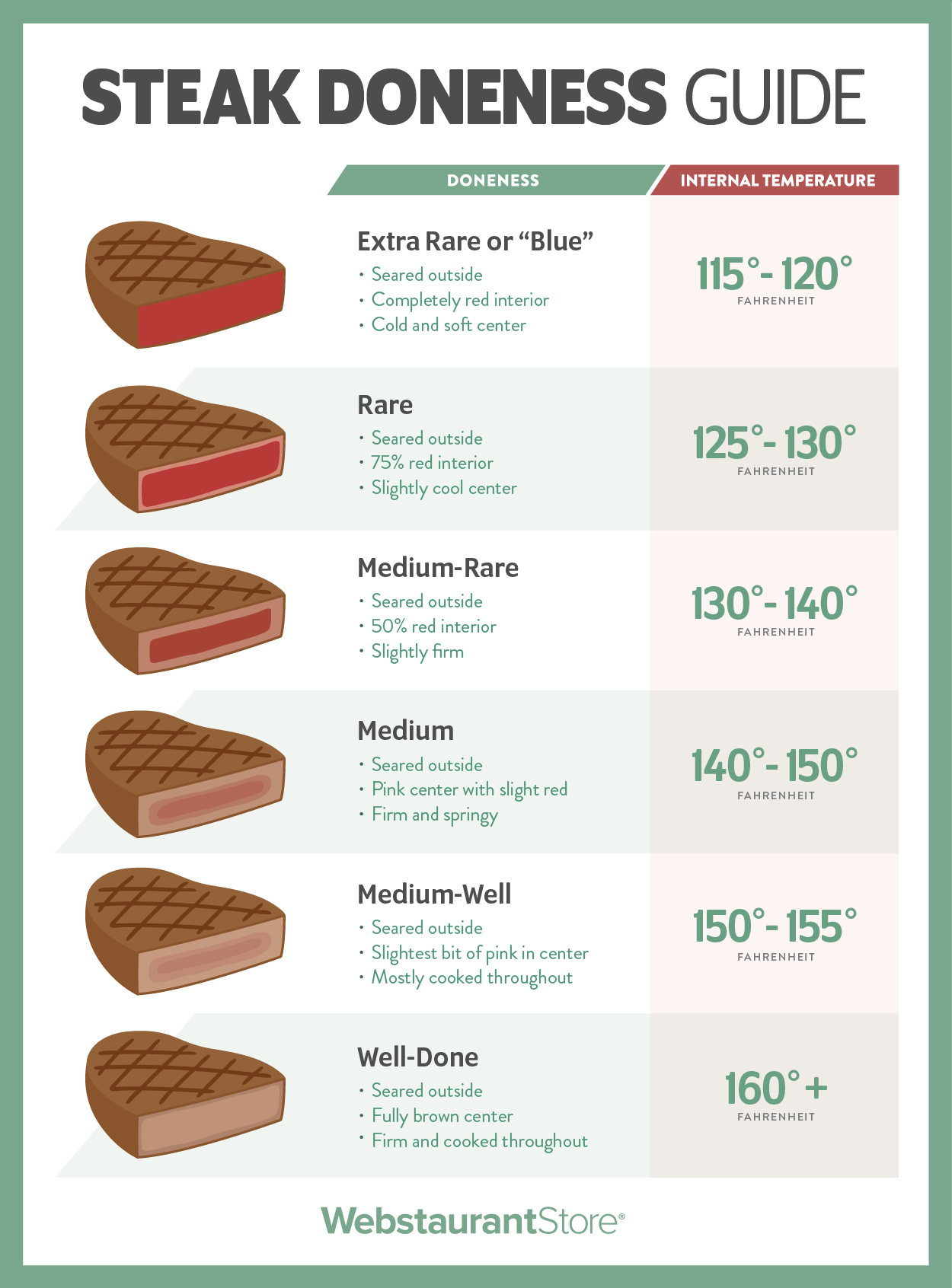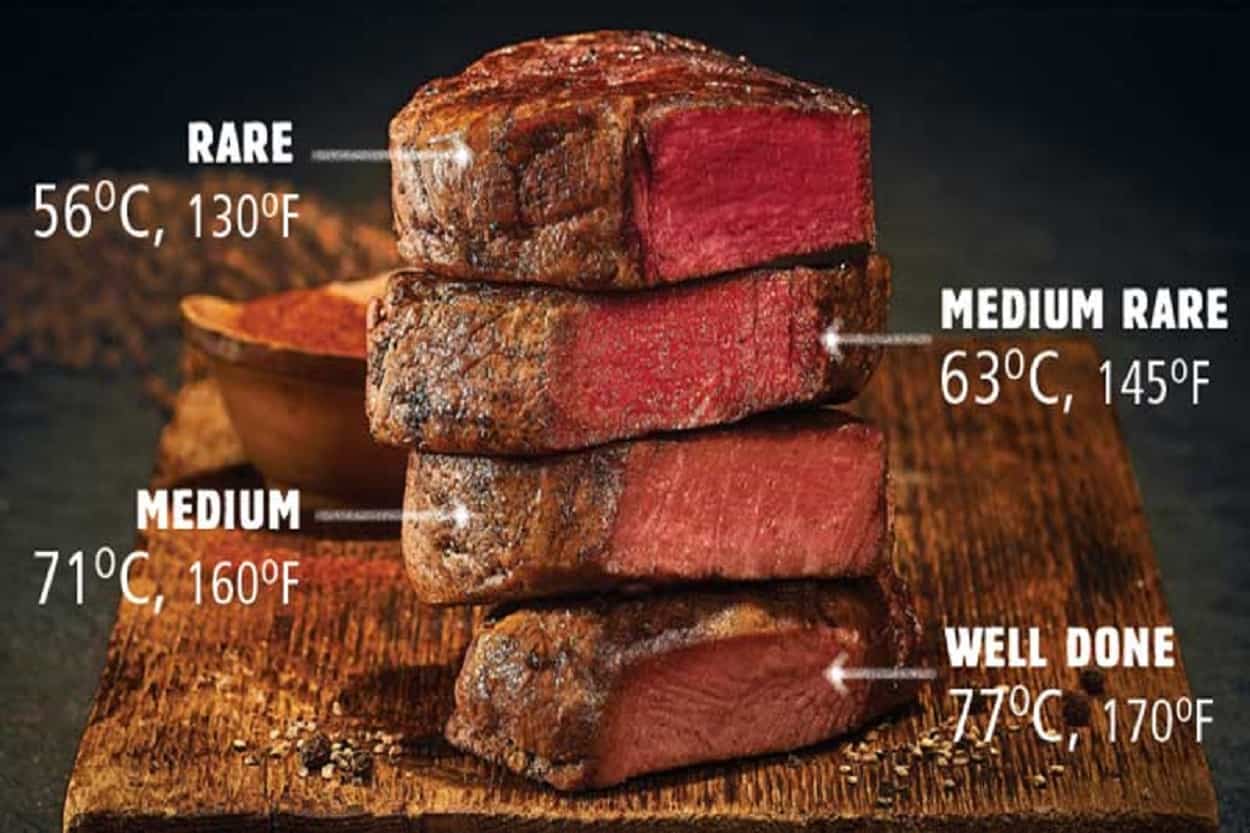Cooking a steak, especially when you like it well done, can feel a bit like a mystery sometimes. You want that lovely, browned outside and a thoroughly cooked inside, but without it becoming tough or dry. It’s a common wish for many folks who enjoy a good piece of beef, and honestly, getting it just right is simpler than you might think. We’re talking about hitting a specific temperature inside the meat that makes all the difference, ensuring every bite is exactly what you hoped for, tender and full of flavor.
Many people, you know, sort of shy away from ordering or even trying to cook a well-done steak at home because of stories about them being like shoe leather. But that’s usually because the internal temperature wasn't quite what it needed to be, or perhaps it went a little too far. The secret, as a matter of fact, really does lie in understanding the heat, and how it moves through the meat, transforming it from raw to wonderfully done without any dryness.
This whole idea of cooking to a precise heat is actually quite a useful skill for anyone who enjoys spending time in the kitchen. It means you can consistently produce food that tastes great, and your steak, particularly, can become a real star. We’ll look at the simple steps to achieve that perfect internal temp for steak well done, making sure your next meal is a true success, every single time.
- Sample Personal Bio
- Shameless Actor
- Katherine Kady Allen
- Oliver Mclanahan Phillips
- Iot Ssh Access Device Aws
Table of Contents
- What's the Ideal Temp for a Steak Well Done?
- Why Aim for a Specific Temp for Steak Well Done?
- Getting Your Steak to That Perfect Temp for Steak Well Done
- Are There Different Ways to Check the Temp for Steak Well Done?
- Common Mistakes When Cooking Steak Well Done
- Resting Your Steak After Reaching the Temp for Steak Well Done
- Enjoying Your Perfectly Cooked Well Done Steak
- Final Thoughts on the Temp for Steak Well Done
What's the Ideal Temp for a Steak Well Done?
When you're aiming for a steak that's truly well done, you’re looking for a specific internal heat. This is, you know, where the meat is cooked all the way through, with no pinkness left inside, but still remains juicy and flavorful. For most beef cuts, that sweet spot for a well-done finish is around 160°F to 170°F (71°C to 77°C). Some folks might even go a little higher, perhaps to 175°F (79°C), but you really do start to risk drying it out at that point. It's a fine balance, you see, between fully cooked and still enjoyable to eat.
Reaching this temperature means that the muscle fibers in the steak have tightened up quite a bit, releasing a good amount of moisture. This is why, arguably, some people find well-done steaks less tender than those cooked to a lower temperature. However, with the right approach, even a well-done steak can be a delightful experience. It’s all about managing the heat and, crucially, not pushing it too far beyond that upper limit. A meat thermometer, you know, becomes your absolute best friend here, taking all the guesswork out of it.
Without a thermometer, it's really just a guessing game, and that's where most well-done steak mishaps happen. You might cut into it too early, find it still a bit pink, and then put it back on, which often leads to overcooking. Or, you might leave it on for too long, just to be sure, and end up with something that’s more like jerky. So, to hit that ideal temp for steak well done, a quick, accurate reading is definitely the way to go, giving you confidence in your cooking every single time.
- British Luxury Fashion Brands
- Love Island Couples Still Together
- Remote Manage Iot Behind Router Example Raspberry Pi
- How Old Was Bieber When He Sang Baby
- Vnc Access Iot Free
Why Aim for a Specific Temp for Steak Well Done?
You might wonder, you know, why bother with a specific temperature when you just want it cooked all the way through? Well, aiming for a precise internal heat, especially for a well-done steak, is about more than just safety; it's about quality. When you hit that particular temp for steak well done, you ensure that any potential concerns about doneness are gone, and what you get is a consistent product. It means that the steak will be cooked to your preference, without any unexpected pink spots, which is important for many who prefer this style of cooking.
Beyond just doneness, though, there’s the matter of texture and taste. Overcooking, which happens when the temperature goes too high, really does break down the proteins too much, squeezing out all the moisture. This results in a steak that’s tough, dry, and frankly, a bit sad. By stopping at that sweet spot, you preserve some of the natural juices and fats within the meat, which are what give it flavor and keep it from becoming too chewy. So, it's not just about cooking it; it's about cooking it *well*.
Furthermore, knowing that exact temperature means you can replicate your success, time and again. It takes the guesswork out of the process, allowing you to confidently cook for yourself or for guests. It’s a bit like baking, where precise measurements are pretty important for a good outcome. For your well-done steak, that temperature reading is your measurement, ensuring that your efforts in the kitchen pay off with a truly satisfying meal. It’s a small detail, perhaps, but one that makes a very big difference, you know.
Getting Your Steak to That Perfect Temp for Steak Well Done
Achieving that just-right internal heat for your well-done steak really does involve a few straightforward steps. First off, you want to start with a piece of meat that's at room temperature, or at least close to it. Taking your steak out of the fridge about 30 minutes before you plan to cook it helps it cook more evenly. If you throw a cold steak onto a hot pan or grill, the outside might get done too quickly while the inside struggles to catch up, making it harder to get that consistent temp for steak well done throughout.
Next, think about your cooking method. For a well-done steak, a consistent, medium heat is often better than a super high heat. While a hot sear is great for building a crust, too much direct, intense heat for too long can burn the outside before the inside gets to where it needs to be. You might consider searing it for a few minutes on each side to get that lovely brown crust, and then moving it to a slightly cooler part of the grill or oven to finish cooking slowly. This gentle approach helps the heat distribute more evenly, giving you a better result.
And then, of course, there's the thermometer. This is, basically, your most important tool. Once your steak looks like it’s getting close, start checking its temperature. Insert the thermometer into the thickest part of the meat, making sure it’s not touching any bone, as bone can give you a false reading. Keep cooking until you hit that 160°F to 170°F mark. It might take a little longer than you expect, but patience here really does pay off with a tender, fully cooked well-done steak.
Are There Different Ways to Check the Temp for Steak Well Done?
You know, when it comes to checking the internal heat of your steak, there are a few different tools and methods you could use, each with its own benefits. The most common and, frankly, the most reliable way is with a good quality meat thermometer. There are a few types, actually, that home cooks often use. An instant-read digital thermometer is probably the most popular choice. You just stick it in, and within a few seconds, it gives you a precise reading. This is great because it means you don't have to leave the oven or grill door open for too long, which helps keep the cooking environment stable.
Another option, for instance, is a probe thermometer, which has a wire that connects the probe in the meat to a display unit outside the oven or grill. This allows you to monitor the temperature continuously without opening the door at all. It’s particularly useful if you’re cooking a thicker cut or using a method where you want to keep a close eye on the temp for steak well done as it slowly climbs. Some even have alarms that will sound when your target temperature is reached, which is pretty handy, you know, for busy cooks.
While less precise, some people still rely on the "touch test," where you compare the firmness of the cooked steak to the firmness of different parts of your hand. For a well-done steak, it should feel quite firm, similar to the heel of your palm when you make a fist. However, this method is really quite subjective and takes a lot of practice to get right consistently. For accuracy and peace of mind, especially when aiming for a specific temp for steak well done, a thermometer is definitely the superior choice, giving you a clear, numerical answer every time.
Common Mistakes When Cooking Steak Well Done
Even with the best intentions, it's easy to fall into a few common traps when trying to cook a well-done steak. One of the biggest errors, you know, is using too high a heat for the entire cooking process. While a good sear is desirable, keeping the heat blasting for too long will result in a burnt, crusty exterior and a dry, tough interior. The outside cooks way too fast, and by the time the inside reaches that desired temp for steak well done, the outer layers are completely overdone. It’s like trying to sprint a marathon; you burn out too quickly.
Another frequent mistake is not using a thermometer, or not using it correctly. Guessing when a steak is well done, perhaps by cutting into it to check, is a recipe for disaster. Each time you cut into the meat, you let out precious juices, making the steak drier. And without a thermometer, you're just relying on visual cues, which can be misleading. You might pull it off too early, or leave it on too long, missing that ideal temp for steak well done entirely. This tool is, basically, a small investment that pays off big in terms of perfectly cooked meat.
Finally, not allowing the steak to rest after cooking is a very common oversight. Many people are so eager to eat their perfectly cooked steak that they slice into it right away. However, during cooking, the juices in the meat get pushed to the center. If you cut it immediately, those juices just spill out onto the cutting board, leaving your steak dry. Resting allows those juices to redistribute throughout the meat, making every bite more tender and flavorful, even for a well-done steak. It's a simple step, yet it makes a huge difference in the final outcome, really.
Resting Your Steak After Reaching the Temp for Steak Well Done
Once your steak hits that perfect internal temp for steak well done, your cooking isn't quite finished, not entirely. The next, and arguably, very important step is to let it rest. This period, usually about 5 to 10 minutes for a typical steak, allows the magic to happen. When meat cooks, its muscle fibers tighten up, pushing the natural juices towards the center. If you cut into it right away, all those delicious, flavorful juices will simply spill out onto your cutting board, leaving your steak dry and less enjoyable.
During the resting period, you know, those juices that were pushed to the middle begin to redistribute throughout the entire piece of meat. This process helps to reabsorb the moisture, making the steak more tender and juicy from edge to edge. Even for a well-done steak, which by its nature has lost more moisture than a rarer one, this step is absolutely crucial for retaining as much succulence as possible. You’ll find that a rested well-done steak is significantly more pleasant to eat than one that was sliced immediately.
To rest your steak, simply take it off the heat once it reaches the desired temp for steak well done and place it on a cutting board or a plate. You can loosely tent it with aluminum foil to keep it warm, but don't wrap it tightly, as that can cause it to steam and overcook. This waiting period might feel like forever, especially when the aroma of cooked steak is filling the kitchen, but it’s a small sacrifice for a much better eating experience. Patience, in this case, really does lead to a more satisfying meal, every time.
Enjoying Your Perfectly Cooked Well Done Steak
After all your careful work, from bringing the steak to room temperature to hitting that ideal temp for steak well done, and then allowing it to rest, you're finally ready for the best part: eating it! Slicing into a well-done steak that's been cooked correctly should reveal a consistent color throughout, perhaps a light brown, with no pinkness at all. What you should also notice, though, is that it still has a pleasant juiciness, not the dry, tough texture that many associate with well-done meat. This is the payoff for paying attention to the temperature and resting.
Serve your well-done steak with your favorite sides. Perhaps some roasted vegetables, a fresh salad, or some creamy mashed potatoes. The beauty of a well-cooked steak, even one that's well done, is its versatility. It can be the star of a simple weeknight dinner or the centerpiece of a more elaborate meal with friends and family. The key is that the meat itself is enjoyable, which comes back to that careful temperature control during cooking. It’s a testament to the fact that even well-done can be truly delicious, you know.
So, next time you or someone you're cooking for asks for a well-done steak, you can approach it with confidence. Forget the old myths about dry, flavorless meat. With a meat thermometer and a little understanding of internal temperatures and resting, you can consistently produce a well-done steak that's tender, juicy, and full of great flavor. It's about respecting the meat and using the right techniques to achieve your desired outcome, making every bite a truly satisfying one. You’ll find, actually, that it's a very rewarding way to cook.
Final Thoughts on the Temp for Steak Well Done
Getting your steak to that just-right temp for steak well done really is a skill that anyone can pick up. It’s less about complicated cooking secrets and more about using the right tools and understanding a few simple principles. The main takeaway, perhaps, is that a meat thermometer is your best friend in this endeavor. It takes all the guesswork out of knowing when your steak has reached that perfect internal heat, ensuring it's cooked through without being overdone and dry.
Remember, aiming for an internal temperature between 160°F and 170°F (71°C to 77°C) is generally what you're looking for. And just as important as hitting that temperature is giving your steak a good rest afterwards. This step, you know, lets the juices settle back into the meat, keeping it tender and flavorful, even when it’s cooked all the way through. It's these small details that truly elevate a simple piece of meat into something quite wonderful.
So, go ahead and confidently cook that well-done steak. With a little attention to temperature and a bit of patience, you can create a meal that’s both satisfying and delicious, proving that well-done doesn’t have to mean dry. It’s all about cooking with purpose and precision, and the results, you’ll find, are well worth the effort, every single time.
Related Resources:



Detail Author:
- Name : Consuelo Lakin PhD
- Username : bergstrom.kirsten
- Email : watsica.tianna@hotmail.com
- Birthdate : 1998-12-31
- Address : 504 Bartoletti Knolls Suite 097 Stoltenbergmouth, SD 68330
- Phone : +17375618814
- Company : Corkery-Cruickshank
- Job : Space Sciences Teacher
- Bio : Quia velit amet explicabo. Qui blanditiis quae sed laudantium. Nihil quidem deleniti illo aut quasi. Omnis quibusdam animi ut rerum reprehenderit maxime.
Socials
linkedin:
- url : https://linkedin.com/in/shanahan1987
- username : shanahan1987
- bio : Et impedit explicabo et voluptas veniam rem quis.
- followers : 934
- following : 717
tiktok:
- url : https://tiktok.com/@sshanahan
- username : sshanahan
- bio : Quis sit aut quasi magni tenetur.
- followers : 2673
- following : 682
twitter:
- url : https://twitter.com/shanahan2013
- username : shanahan2013
- bio : Non nemo et ut. Quis autem explicabo in id nulla. Molestiae et iste doloremque qui architecto hic. Voluptas non ut et necessitatibus alias et.
- followers : 6193
- following : 780
facebook:
- url : https://facebook.com/santiago.shanahan
- username : santiago.shanahan
- bio : Quis commodi facilis iusto consequatur et excepturi eius.
- followers : 187
- following : 2786
instagram:
- url : https://instagram.com/santiago_shanahan
- username : santiago_shanahan
- bio : Quis vero iure sint. Qui quod enim eum. Aut alias officiis et est natus.
- followers : 2350
- following : 715